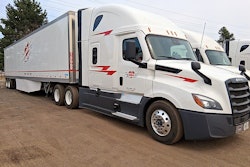Though truckload and less-than-trucking pricing showed signs of progress, trade policies and low consumer confidence are likely to prolong low demand and suspend freight market recovery, according to the TD Cowen and AFS Freight Index Q2 forecast.
Despite a modest bump, truckload pricing remained weak in Q1, with rates showing little sign of sustained recovery. Meanwhile, LTL pricing discipline helped maintain rate stability, while parcel carriers intensified their use of tactical price adjustments to extract more revenue from shrinking shipment volumes.
“Tariffs have become the topic du jour in boardrooms and beyond, and combining those policy changes with a cloudy macroeconomic picture is a recipe for the uncertainty and caution that characterize current market sentiment,” said Andy Dyer, CEO of AFS Logistics.
The report indicated that truckload rates saw a slight lift in Q1, with the per-mile index rising to 5.9% above the January 2018 benchmark. This increase was driven by pre-tariff inventory acceleration, disruptions from wildfires and other natural events, and ongoing corrections in freight capacity.
However, the report pointed out that a shift toward shorter-haul shipments (hauls under 500 miles) pushed total shipment costs down to 5% above pre-pandemic levels, marking the lowest point in over three years.
In Q2, the forecast suggests a mild dip to 5.5% above baseline, continuing a nine-quarter streak of rates between 4.3% and 5.9% above the 2018 baseline.
[RELATED: Nearly 90% of companies adjusted supply chains in Q1]
Public carriers felt the impact of tariff-driven shifts in various ways.
J.B. Hunt (CCJ Top 250, No.3) executives said in their earnings call that customers are planning multiple "what-if" scenarios.
“But most of them are waiting for the dust to settle on their short- and -long-term business strategies,” said Spencer Frazier, the company’s executive vice president of sales and marketing.
Despite all other segments declining, intermodal saw some gains, with revenue increasing by 5% and volume increasing by 8%. The company said demand in the segment remained strong and delivered “the highest first-quarter volume in our country’s history.”
However, Brad Hicks, J.B. Hunt executive vice president and president of dedicated contract services, also added that some customers are delaying contract decisions and taking a more conservative approach, even with a long contracting process that typically takes about 18 months to close.
“Admittedly, we have seen some customers take a little longer to execute contracts as they are taking a more wait-and-see approach," Hicks said.
J.B. Hunt execs also noted that some customers are implementing various strategies, including pulling forward inventory, pausing some shipments and possibly cancelling a few, or changing origin of manufacturer, viewing it as an opportunity to be resilient.
“When the dust settles, it will create opportunities for us to grow with our customers and serve them with our broad suite of services from a position of strength,” Frazier said.
Schneider (No.6) saw its intermodal earnings double from a year ago. CEO Mark Rourke noted that some customers pulled shipments forward to respond to tariff concerns, particularly increasing intermodal activity in western Mexico. However, he noted uncertainty about the stability of strong volumes.
“It [can] all come down to magnitude, duration, and timing, which is uncertain for us going forward," he said.
Knight-Swift (No.4) also saw limited upside from the tariff pull-forward. While the company anticipated a seasonal volume rebound in March following February’s extreme weather, this momentum was disrupted by market uncertainties.
In its earnings call, CEO Adam Miller said that having spoken to 40 to 50 of its largest shipper clients, many adopted cautious approaches. This includes going forward on current strategy and holding off on changes related to duties, reducing or stopping purchases from China, or drawing down existing inventory.
“Our customers are expressing more concern around cost impacts of tariffs and less concern regarding demand from their customers,” as they project near-term disruptions, Miller said. “However, if consumer spending remains steady, goods will have to move at some point, and that may create opportunities for carriers that are proven to be nimble with scale, like many of our Knight-Swift truckload brands.”
[RELATED: Shippers and carriers brace for cost pressures and sustainability challenges]
In the LTL sector, pricing strength continues despite economic challenges.
The forecast report noted that Q1 saw the implementation of general rate increases (GRI) and a 4% uptick in fuel surcharges per shipment. These factors offset headwinds from shorter hauls and lighter weights, resulting in a 1.5% quarterly and 0.5% annual increase in cost per shipment.
For Q2, the rate per pound index is projected at 63.4%, slightly down from Q1 but still up 0.7% year-over-year, extending a six-quarter trend of yearly growth.
Meanwhile, the forecast pointed out that parcel carriers have shifted away from predictable, annual pricing cycles. Instead, UPS (No.2) and FedEx (No.1) are deploying faster, more frequent pricing adjustments to counter soft demand.
In the first quarter of the year, UPS has made several changes: new ZIP code-zone alignments, new fees on paper billing, check and wire payments, increased late fees, and a new processing charge. Both carriers also adjusted fuel surcharges, with UPS ground fuel surcharges up 15% and FedEx’s up 12% year-over-year, even as diesel fuel dropped 8.4%. UPS also announced plans to cut approximately 20,000 jobs and close 73 facilities as it forecasts a 9% year-over-year decline in average daily U.S. domestic volume in Q2, which the company is attributing to reduced Amazon shipments and weaker consumer demand.













